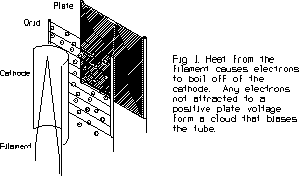How Tubes Work, Briefly
adapted from an article by John Simonton
Fig 1 shows a typical triode vacuum tube. Because of thermionic emission (otherwise called "Edison Effect"), heat from the filament causes electrons to boil off of the oxide coating of the cathode. The positive voltage on the plate attracts the electrons, and the moving electrons produce a current flow. A negative bias voltage on the grid (as compared to the cathode) repels some of the electrons and prevents them from reaching the plate, resulting in reduced current flow. In this way a changing charge on the grid modulates the plate current. Vacuum tubes exhibit "transconductance" in that a voltage on the grid controls electron "plate current" flow.
One of the sources of non-linearity in vacuum tubes is "space charge", i.e., electrons that leave the cathode but don't make it to the plate accumulate in a plasma cloud surrounding the hot cathode. This cloud of negatively charged electrons has the general effect of a negative voltage applied to the grid - it tends to decrease current flow. This is sometimes described as "self-biasing," a self-reinforcing, non-linear effect.
Reduced Plate Voltage Operation, or "Brown Sound" (in guitar amps)
Operating a vacuum tube at low plate voltage doesn't greatly affect the number of electrons that leave the cathode, as heat primarily determines the plasma electron cloud. At low plate voltages (and currents) space charge becomes an important factor (just as many electrons are leaving the cathode due to heat, but fewer of them are drawn to the plate), exaggerating any non-linearities.
The "Starved tube" circuitry operates at such low voltage and current that it completely self-biases. High impedance scopes and voltmeters can measure the voltage between any of the grids and ground (cathode), revealing a natural field of 1 or more volts negative, the result of electrons boiling off the cathode and surrounding the cathoed and control grid.

Material herein added and updated constantly; presented for inspirational and educational purposes per Fair Use.
Last modified 21 Aug 2025
